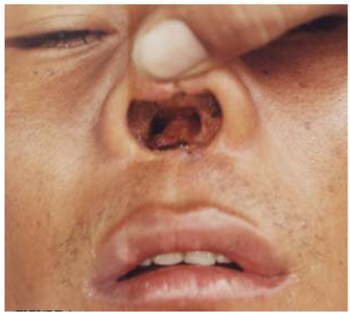Mucocutaneous leishmaniasis
| Mucocutaneous leishmaniasis | |
|---|---|
 | |
| Mucocutaneous leishmaniasis (MCL) | |
| Specialty | Infectious disease |
| Frequency | Lua error in Module:PrevalenceData at line 5: attempt to index field 'wikibase' (a nil value). |
Mucocutaneous leishmaniasis is an especially disturbing form of cutaneous leishmaniasis, because it produces destructive and disfiguring lesions of the face. It is most often caused by Leishmania braziliensis, but cases caused by L. aethiopica have also been described.[1]
Mucocutaneous leishmaniasis is very difficult to treat. Treatment involves the use of pentavalent antimonial compounds, which are highly toxic (common side effects include thrombophlebitis, pancreatitis, cardiotoxicity and hepatotoxicity) and not very effective. For example, in one study, despite treatment with high doses of sodium stibogluconate for 28 days, only 30% of patients remained disease-free at 12 months follow-up.[2] Even in those patients who achieve an apparent cure, as many as 19% will relapse.[3] Several drug combinations with immunomodulators have been tested, for example, a combination of pentoxifylline (inhibitor of TNF-α) and a pentavalent antimonial at a high dose for 30 days in a small-scale (23 patients) randomised placebo-controlled study from Brazil achieved cure rates of 90% and reduced time to cure,[4] a result that should be interpreted cautiously in light of inherent limitations of small-scale studies.[5] In an earlier small-scale (12 patients) study, addition of imiquimod showed promising results[6] which need yet to be confirmed in larger trials.[citation needed]
References
- ↑ van Griensven, Johan; Gadisa, Endalamaw; Aseffa, Abraham; Hailu, Asrat; Beshah, Abate Mulugeta; Diro, Ermias (3 March 2016). "Treatment of Cutaneous Leishmaniasis Caused by Leishmania aethiopica: A Systematic Review". PLOS Neglected Tropical Diseases. 10 (3): e0004495. doi:10.1371/journal.pntd.0004495.
- ↑ Franke ED, Wignall FS, Cruz ME, Rosales E, Tovar AA, Lucas CM, Llanos-Cuentas A, Berman JD (December 1990). "Efficacy and toxicity of sodium stibogluconate for mucosal leishmaniasis". Annals of Internal Medicine. 113 (12): 934–40. doi:10.7326/0003-4819-113-12-934. PMID 2173461.
- ↑ Netto EM, Marsden PD, Llanos-Cuentas EA, Costa JM, Cuba CC, Barreto AC, Badaró R, Johnson WD, Jones TC (1990). "Long-term follow-up of patients with Leishmania (Viannia) braziliensis infection and treated with Glucantime". Transactions of the Royal Society of Tropical Medicine and Hygiene. 84 (3): 367–70. doi:10.1016/0035-9203(90)90321-5. PMID 2260171.
- ↑ Machado PR, Lessa H, Lessa M, Guimarães LH, Bang H, Ho JL, Carvalho EM (March 2007). "Oral pentoxifylline combined with pentavalent antimony: a randomized trial for mucosal leishmaniasis". Clinical Infectious Diseases. 44 (6): 788–93. doi:10.1086/511643. PMID 17304449.
- ↑ Ojha RP, Cervantes D, Fischbach LA (October 2007). "Oral pentoxifylline and pentavalent antimony for treatment of leishmaniasis: promising but inconclusive evidence of superiority, compared with antimony monotherapy". Clinical Infectious Diseases. 45 (8): 1104, author reply 1005–6. doi:10.1086/521938. PMID 17879933.
- ↑ Arevalo I, Ward B, Miller R, Meng TC, Najar E, Alvarez E, Matlashewski G, Llanos-Cuentas A (December 2001). "Successful treatment of drug-resistant cutaneous leishmaniasis in humans by use of imiquimod, an immunomodulator". Clinical Infectious Diseases. 33 (11): 1847–51. doi:10.1086/324161. PMID 11692295.